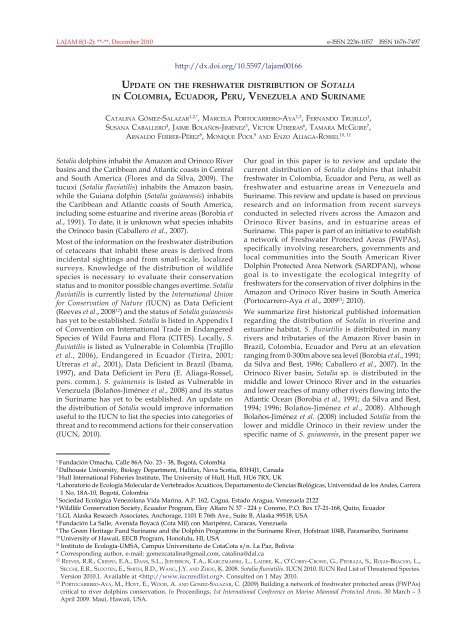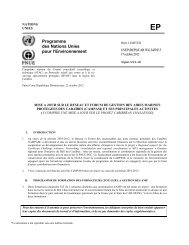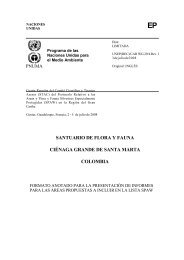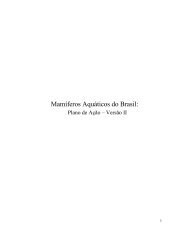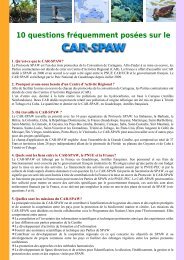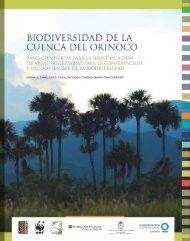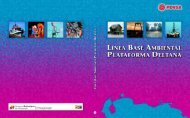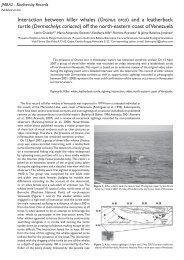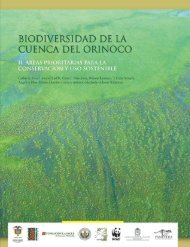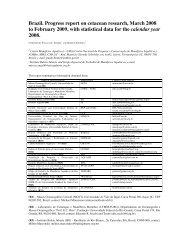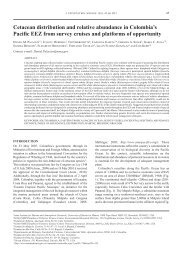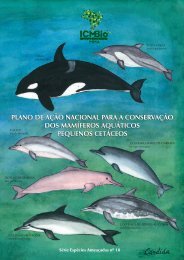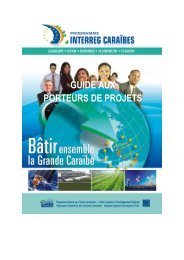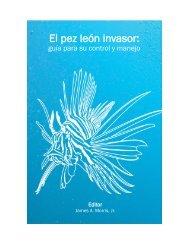18 Gomez Salazar et al.pmd
18 Gomez Salazar et al.pmd
18 Gomez Salazar et al.pmd
Create successful ePaper yourself
Turn your PDF publications into a flip-book with our unique Google optimized e-Paper software.
LAJAM 8(1-2): **-**, December 2010 e-ISSN 2236-1057 ISSN 1676-7497http://dx.doi.org/10.5597/lajam00166UPDATE ON THE FRESHWATER DISTRIBUTION OF SOTALIAIN COLOMBIA, ECUADOR, PERU, VENEZUELA AND SURINAMECATALINA GÓMEZ-SALAZAR 1,2,* , MARCELA PORTOCARRERO-AYA 1,3 , FERNANDO TRUJILLO 1 ,SUSANA CABALLERO 4 , JAIME BOLAÑOS-JIMÉNEZ 5 , VÍCTOR UTRERAS 6 , TAMARA MCGUIRE 7 ,ARNALDO FERRER-PÉREZ 8 , MONIQUE POOL 9 10, 11AND ENZO ALIAGA-ROSSELSot<strong>al</strong>ia dolphins inhabit the Amazon and Orinoco Riverbasins and the Caribbean and Atlantic coasts in Centr<strong>al</strong>and South America (Flores and da Silva, 2009). Th<strong>et</strong>ucuxi (Sot<strong>al</strong>ia fluviatilis) inhabits the Amazon basin,while the Guiana dolphin (Sot<strong>al</strong>ia guianensis) inhabitsthe Caribbean and Atlantic coasts of South America,including some estuarine and riverine areas (Borobia <strong>et</strong><strong>al</strong>., 1991). To date, it is unknown what species inhabitsthe Orinoco basin (Cab<strong>al</strong>lero <strong>et</strong> <strong>al</strong>., 2007).Most of the information on the freshwater distributionof c<strong>et</strong>aceans that inhabit these areas is derived fromincident<strong>al</strong> sightings and from sm<strong>al</strong>l-sc<strong>al</strong>e, loc<strong>al</strong>izedsurveys. Knowledge of the distribution of wildlifespecies is necessary to ev<strong>al</strong>uate their conservationstatus and to monitor possible changes overtime. Sot<strong>al</strong>iafluviatilis is currently listed by the Internation<strong>al</strong> Unionfor Conservation of Nature (IUCN) as Data Deficient(Reeves <strong>et</strong> <strong>al</strong>., 2008 12 ) and the status of Sot<strong>al</strong>ia guianensishas y<strong>et</strong> to be established. Sot<strong>al</strong>ia is listed in Appendix Iof Convention on Internation<strong>al</strong> Trade in EndangeredSpecies of Wild Fauna and Flora (CITES). Loc<strong>al</strong>ly, S.fluviatilis is listed as Vulnerable in Colombia (Trujillo<strong>et</strong> <strong>al</strong>., 2006), Endangered in Ecuador (Tirira, 2001;Utreras <strong>et</strong> <strong>al</strong>., 2001), Data Deficient in Brazil (Ibama,1997), and Data Deficient in Peru (E. Aliaga-Rossel,pers. comm.). S. guianensis is listed as Vulnerable inVenezuela (Bolaños-Jiménez <strong>et</strong> <strong>al</strong>., 2008) and its statusin Suriname has y<strong>et</strong> to be established. An update onthe distribution of Sot<strong>al</strong>ia would improve informationuseful to the IUCN to list the species into categories ofthreat and to recommend actions for their conservation(IUCN, 2010).Our go<strong>al</strong> in this paper is to review and update thecurrent distribution of Sot<strong>al</strong>ia dolphins that inhabitfreshwater in Colombia, Ecuador and Peru, as well asfreshwater and estuarine areas in Venezuela andSuriname. This review and update is based on previousresearch and on information from recent surveysconducted in selected rivers across the Amazon andOrinoco River basins, and in estuarine areas ofSuriname. This paper is part of an initiative to establisha n<strong>et</strong>work of Freshwater Protected Areas (FWPAs),specific<strong>al</strong>ly involving researchers, governments andloc<strong>al</strong> communities into the South American RiverDolphin Protected Area N<strong>et</strong>work (SARDPAN), whosego<strong>al</strong> is to investigate the ecologic<strong>al</strong> integrity offreshwaters for the conservation of river dolphins in theAmazon and Orinoco River basins in South America(Portocarrero-Aya <strong>et</strong> <strong>al</strong>., 2009 13 ; 2010).We summarize first historic<strong>al</strong> published informationregarding the distribution of Sot<strong>al</strong>ia in riverine andestuarine habitat. S. fluviatilis is distributed in manyrivers and tributaries of the Amazon River basin inBrazil, Colombia, Ecuador and Peru at an elevationranging from 0-300m above sea level (Borobia <strong>et</strong> <strong>al</strong>., 1991;da Silva and Best, 1996; Cab<strong>al</strong>lero <strong>et</strong> <strong>al</strong>., 2007). In theOrinoco River basin, Sot<strong>al</strong>ia sp. is distributed in themiddle and lower Orinoco River and in the estuariesand lower reaches of many other rivers flowing into theAtlantic Ocean (Borobia <strong>et</strong> <strong>al</strong>., 1991; da Silva and Best,1994; 1996; Bolaños-Jiménez <strong>et</strong> <strong>al</strong>., 2008). AlthoughBolaños-Jiménez <strong>et</strong> <strong>al</strong>. (2008) included Sot<strong>al</strong>ia from thelower and middle Orinoco in their review under thespecific name of S. guianensis, in the present paper we1Fundación Omacha, C<strong>al</strong>le 86A No. 23 - 38, Bogotá, Colombia2D<strong>al</strong>housie University, Biology Department, H<strong>al</strong>ifax, Nova Scotia, B3H4J1, Canada3Hull Internation<strong>al</strong> Fisheries Institute, The University of Hull, Hull, HU6 7RX, UK4Laboratorio de Ecología Molecular de Vertebrados Acuáticos, Departamento de Ciencias Biológicas, Universidad de los Andes, Carrera1 No. <strong>18</strong>A-10, Bogotá, Colombia5Sociedad Ecológica Venezolana Vida Marina, A.P. 162, Cagua, Estado Aragua, Venezuela 21226Wildlife Conservation Soci<strong>et</strong>y, Ecuador Program, Eloy Alfaro N 37 - 224 y Coremo, P.O. Box 17-21-168, Quito, Ecuador7LGL Alaska Research Associates, Anchorage, 1101 E 76th Ave., Suite B, Alaska 995<strong>18</strong>, USA8Fundación La S<strong>al</strong>le, Avenida Boyacá (Cota Mil) con Maripérez, Caracas, Venezuela9The Green Heritage Fund Suriname and the Dolphin Programme in the Suriname River, Hofstraat 104B, Paramaribo, Suriname10University of Hawaii, EECB Program, Honolulu, HI, USA11Instituto de Ecología-UMSA, Campus Universitario de CotaCota s/n. La Paz, Bolivia* Corresponding author, e-mail: gomezcat<strong>al</strong>ina@gmail.com, cat<strong>al</strong>ina@d<strong>al</strong>.ca12REEVES, R.R., CRESPO, E.A., DANS, S.L., JEFFERSON, T.A., KARCZMARSKI, L., LAIDRE, K., O’CORRY-CROWE, G., PEDRAZA, S., ROJAS-BRACHO, L.,SECCHI, E.R., SLOOTEN, E., SMITH, B.D., WANG, J.Y. AND ZHOU, K. 2008. Sot<strong>al</strong>ia fluviatilis. IUCN 2010. IUCN Red List of Threatened Species.Version 2010.1. Available at . Consulted on 1 May 2010.13PORTOCARRERO-AYA, M., HOYT, E., WOOD, A. AND GOMEZ-SALAZAR, C. (2009) Building a n<strong>et</strong>work of freshwater protected areas (FWPAs)critic<strong>al</strong> to river dolphins conservation. In Proceedings, 1st Internation<strong>al</strong> Conference on Marine Mamm<strong>al</strong> Protected Areas. 30 March – 3April 2009. Maui, Hawaii, USA.
UPDATE ON THE FRESHWATER DISTRIBUTION OF SOTALIA IN COLOMBIA, ECUADOR, PERU, VENEZUELA AND SURINAME 3of S. fluviatilis were recorded in the Cuyabeno and NapoRivers. Two more surveys were conducted in theMamoré and Itenez Rivers (Bolivian Amazon) but noSot<strong>al</strong>ia were sighted and there are <strong>al</strong>so no historic<strong>al</strong>records for these rivers (da Silva and Best, 1996).Three surveys were conducted in the Orinoco Riverbasin (Figure 2). In Venezuela, surveys were conductedin the Orinoco River, starting from the town of Mapire,State of Anzoátegui, going upstream to the city ofPuerto Carreño (Colombia) and later starting from thecity of Tucupita, State of Delta Amacuro (Venezuela),and ending at the river mouth in the North AtlanticOcean, across from Trinidad and Tobago. Five channelsin this delta were surveyed. Sot<strong>al</strong>ia dolphins wererecorded in <strong>al</strong>l surveys upto the Parguaza rapids,~20km away from the border with Colombia(6°41’491"N, 67°6’563"W) and ~800km from the mouthof the Orinoco. The Parguaza rapids do not seem to bea compl<strong>et</strong>e natur<strong>al</strong> barrier. In fact, during the rainyseason when the water level in the river increases, theserapids <strong>al</strong>most disappear. In the Colombian Orinoco,surveys were conducted <strong>al</strong>l through the M<strong>et</strong>a River.Sot<strong>al</strong>ia were not sighted and are not historic<strong>al</strong>lyreported to occur there.The current distribution of S. guianensis in Surinamecan be described based on the surveys conducted inthe Suriname River estuary by the DolphinProgramme of the Green Heritage Fund Suriname. S.guianensis are distributed in the estuary area of thecoast of Suriname and they make incursions into theSuriname River up to ~23km from the mouth of theriver (Paramaribo City).Based on the above review of historic<strong>al</strong> and currentrecords, we present an update of the distribution ofS. fluviatilis in the Colombian, Ecuadorian andPeruvian Amazon, of Sot<strong>al</strong>ia sp. in the VenezuelanOrinoco, and of S. guianensis in estuarine and riverineareas of Suriname (Figure 3).Over<strong>al</strong>l, dolphins of the genus Sot<strong>al</strong>ia in freshwater aredistributed through most of the Amazon and OrinocoRivers, some of their main tributaries, and estuariesin the Caribbean and Atlantic coasts in South America.The freshwater distribution of S. fluviatilis and Sot<strong>al</strong>iasp. in the middle Orinoco is limited by sh<strong>al</strong>low waters,large rocks, waterf<strong>al</strong>ls, sm<strong>al</strong>l channels and rapids,such as the rapids at the western upper Amazon,and in other areas like the Cordoba rapids in theCaqu<strong>et</strong>á River, the Estrella and Puerco rapids in theApaporis River (Colombia), and the Parguazarapids in the middle Orinoco (Venezuela). Thus,Sot<strong>al</strong>ia dolphins do not reach the Bolivian Amazon orthe Colombian Orinoco.Figure 1. Sightings (2006–2009) records of Sot<strong>al</strong>ia fluviatilis in the Colombian, Ecuadorian and Peruvian Amazon basin.LAJAM 8(1-2): **-**, December 2010
4 C.GÓMEZ-SALAZAR <strong>et</strong> <strong>al</strong>.Figure 2. Sightings (2006–2009) of Sot<strong>al</strong>ia sp. in the Venezuelan Orinoco basin.Figure 3. Distribution of Sot<strong>al</strong>ia in the Amazon (Colombia, Ecuador, Peru), Orinoco (Venezuela) and Suriname.LAJAM 8(1-2): **-**, December 2010
UPDATE ON THE FRESHWATER DISTRIBUTION OF SOTALIA IN COLOMBIA, ECUADOR, PERU, VENEZUELA AND SURINAME 5Amazon River basin - S. fluviatilis is distributed throughoutthe Ucay<strong>al</strong>i River in Peru, considered the main headwaterof the Amazon River, and its confluence with theMarañón River, where the Amazon River begins. S.fluviatilis is <strong>al</strong>so distributed through the Pacaya-SamiriaNation<strong>al</strong> Reserve, including the Samiria and Pacaya riversand lakes such as Tipishca del Samiria and San Pablo deTipishca. There are <strong>al</strong>so records of Sot<strong>al</strong>ia from theMarañon River and from its major tributaries that flowsoutheasterly from Ecuador: the Pastaza, Morona, Tigreand Napo rivers. The Pastaza River and its tributary, theBobonaza River, are located in the southern EcuadorianAmazon. There are some records in the Morona River,par<strong>al</strong>lel to the Pastaza, and sever<strong>al</strong> of its tributaries (theMangosiza, Cushuimi, Cangaime, Makuma and Wichimirivers). Fin<strong>al</strong>ly, fewer records of S. fluviatilis occur in theNapo River in northern Ecuador, and some of itstributaries such as the Panayacu, the Tiputini, the Yasuníand the Aguarico (which receives the Cuyabeno andLagarto Cocha Rivers). S. fluviatilis is distributed widelythroughout the Amazon River as it flows through thesouthernmost region of Colombia, receiving the Lor<strong>et</strong>oYacu (El Correo and Tarapoto Lakes), Atacuari, andAmacayacu tributaries and the Cab<strong>al</strong>lo Cocha Lake onthe border with Peru and the Javari River on the borderof Peru and Brazil. In addition, S. fluviatilis is distributedin southwest Colombia in the Putumayo and Caqu<strong>et</strong>árivers <strong>al</strong>ong the border of Ecuador and Peru. ThePutumayo and Caqu<strong>et</strong>á Rivers are main tributariesflowing southeast into the Amazon River in Brazil, wher<strong>et</strong>heir names change to Içá and Japurá, respectively. Themost northwestern records of S. fluviatilis in the AmazonRiver basin are from the Apaporis River, a tributary ofthe Caqu<strong>et</strong>á River in Colombia.Orinoco river basin - Sot<strong>al</strong>ia sp. is distributed across theOrinoco River (middle and lower Orinoco basin) inVenezuela, beginning 20km from the border ofColombia where the Parguaza rapids are formed,~815km away from the river mouth. In the middleOrinoco basin, Sot<strong>al</strong>ia is distributed 1-3km upriver fromthe Parguaza and Cinaruco Rivers (major tributaries ofthe Orinoco River). In the lower Orinoco basin, Sot<strong>al</strong>ia(possibly S. guianensis) is found in the river mouth wher<strong>et</strong>he Orinoco River forms a wide delta that createshundreds of tributaries and channels that flow northeastinto the North Atlantic Ocean.In Colombia, Sot<strong>al</strong>ia dolphins are not present in the upperand middle Orinoco basin south of the confluence withthe M<strong>et</strong>a River in waters shared by Colombia andVenezuela. Therefore, the closest Sot<strong>al</strong>ia population isfrom coast<strong>al</strong> areas of the Atlantic Ocean (S. guianensis)(Cab<strong>al</strong>lero <strong>et</strong> <strong>al</strong>., 2007). Sot<strong>al</strong>ia in the Orinoco River werepreviously thought to be S. guianensis making incursionsof up to 800km upriver (Borobia <strong>et</strong> <strong>al</strong>., 1991; Boher <strong>et</strong> <strong>al</strong>.,1995; Trujillo <strong>et</strong> <strong>al</strong>., 2000; Cab<strong>al</strong>lero <strong>et</strong> <strong>al</strong>., 2007; Bolaños-Jiménez <strong>et</strong> <strong>al</strong>., 2008). However, S. guianensis is significantlylarger than S. fluviatilis (Flores and da Silva, 2009) andindividu<strong>al</strong>s from the middle Orinoco appear to be sm<strong>al</strong>lerthan individu<strong>al</strong>s in the delta of the Orinoco. In terms ofmorphology, individu<strong>al</strong>s observed in the middle Orinocoin Venezuela have a dors<strong>al</strong> fin that has a more slenderbase, more similar to their counterparts in the Amazonbasin, than to S. guianensis in the lower Orinoco. Sot<strong>al</strong>iaobserved in the lower Orinoco (at about 12-15km upriverfrom the Atlantic Ocean) have a wider dors<strong>al</strong> fin base,do not have pink coloration patterns in their flanks, andtheir eyes appear to be bigger than S. fluviatilis, and moresimilar to S. guianensis (Figure 4). We suggest that Sot<strong>al</strong>iadolphins in the Orinoco delta in Venezuela are in fact S.guianensis making incursions into the river. Gen<strong>et</strong>ic andmorphologic<strong>al</strong> studies are urgently needed to clarifywh<strong>et</strong>her populations in the middle Orinoco of Venezuelaare coast<strong>al</strong> transients making incursions into the river orpart of a population that entered via the Amazon to theOrinoco (Borobia <strong>et</strong> <strong>al</strong>., 1991; Boher <strong>et</strong> <strong>al</strong>., 1995; Cunha <strong>et</strong><strong>al</strong>., 2005; Cab<strong>al</strong>lero <strong>et</strong> <strong>al</strong>., 2007) or perhaps anothersubspecies or species <strong>al</strong>tog<strong>et</strong>her.Differences in the colouration patterns b<strong>et</strong>ween Sot<strong>al</strong>iaspecies are interesting and worth investigating. S.fluviatilis in the Amazon River basin are light grey andtheir flanks vary from white to pink that continuesthrough their abdomen (da Silva and Best, 1996; Figure4). S. guianensis in Suriname are light grayish-blue todark grey and <strong>al</strong>so have flanks that vary from pink tolight pink and white. However, the colour in their flanksappears to continue through to their abdomen. This isin contrast to S. fluviatilis in the Amazon, which have agrey streak in b<strong>et</strong>ween the light coloration of their flanks(Figure 4). Sot<strong>al</strong>ia dolphins in the lower Orinoco do notappear to have any pink in their flanks, and Sot<strong>al</strong>iadolphins in the middle Orinoco have some pink colourin their flanks.Suriname - Currently, S. guianensis in the Suriname Riverhas only been recorded up to ~23km up from the rivermouth (Paramaribo city), much less than the ~58kmupriver previously recorded by Husson (1978) in daSilva and Best (1996). It is of serious concern thatpollution from Paramaribo city may be one of the factorscausing this restriction in their movements (M. Pool,pers. comm.). S. guianensis is <strong>al</strong>so recorded in theCommewijne River (~38km from the Suriname Rivermouth) and they are occasion<strong>al</strong>ly seen up to the loc<strong>al</strong>ityof Bakkie during the long dry season. In addition, thereare reports of S. guianensis in the Corantijn River, theMarowijne and the Coppename Rivers. Over<strong>al</strong>l, S.guianensis only swim upriver during the dry seasonwhen the s<strong>al</strong>twater incursion is further upriver and thes<strong>al</strong>inity of the water is high enough.As fin<strong>al</strong> remarks, we think that the results of thiscompilation of available information on the distributionof Sot<strong>al</strong>ia in freshwater of Ecuador, Peru, Colombia,Venezuela and Suriname are useful for identificationof some of the major natur<strong>al</strong> barriers for this species,and provide a baseline for monitoring future changesin their geographic range. The current distribution ofS. fluviatilis in the Colombian and Peruvian AmazonLAJAM 8(1-2): **-**, December 2010
6 C.GÓMEZ-SALAZAR <strong>et</strong> <strong>al</strong>.Figure 4. Colouration patterns and dors<strong>al</strong> fins of a) Sot<strong>al</strong>ia fluviatilis in the Amazon River (Colombia), b) Sot<strong>al</strong>ia sp. in the deltaof the Orinoco River (Venezuela) and c) Sot<strong>al</strong>ia guianensis in the estuary of the Suriname River.basin has not changed compared to historic<strong>al</strong> records.The distribution of S. fluviatilis in the EcuadorianAmazon needs to be asseessed in more d<strong>et</strong>ail. It is ofserious concern that the sighting rate was much lowerduring the recent surveys in the Ecuadorian Amazoncompared to other locations studied. Also, the currentand increasing effects of water pollution by oil industry,noise pollution, and other forms of habitat degradationin the western areas near the Andean mountains are ofconcern (Utreras, 2001; Utreras <strong>et</strong> <strong>al</strong>., 2010). Thedistribution of S. guianensis in the Suriname Riverappears to be changing, with dolphins not moving asfar upriver as previously reported. Wh<strong>et</strong>her thesechanges are related to high levels of pollution from thecity, or other causes, should be investigated. A longtermmonitoring program in these areas is highlyrecommended. In addition, we present currentinformation that suggests that Sot<strong>al</strong>ia in the middleOrinoco River may be more similar, morphologic<strong>al</strong>lyat least, to S. fluviatilis in the Amazon than to S. guianensisin the delta of the Orinoco and <strong>al</strong>ong the coast. Werecommend gen<strong>et</strong>ic studies to identify what species us<strong>et</strong>he middle and lower Orinoco basin in Venezuela.AcknowledgementsThis study was supported by the Wh<strong>al</strong>e and DolphinConservation Soci<strong>et</strong>y (WDCS), Whitley Fund for Nature,Wildlife Conservation Soci<strong>et</strong>y (WCS), World WildlifeFund (WWF), Fundación la S<strong>al</strong>le, Russell E. Trainprogram (WWF), Organization of American States (OAS)Scholarship, Nation<strong>al</strong> Geographic Soci<strong>et</strong>y (NGS), Soci<strong>et</strong>yfor Marine Mamm<strong>al</strong>ogy Sm<strong>al</strong>l Grant in Aid of Research,C<strong>et</strong>acean Soci<strong>et</strong>y Internation<strong>al</strong> (CSI), Humboldt Institute(Colombia), P. L<strong>et</strong>t Fund, F. Gonz<strong>al</strong>ez del Ministerio delAmbiente (Ecuador), authorities from the Ministerio delPoder Popular para el Ambiente (Venezuela), DEA DeltaAmacuro (Venezuela), Guardia Nacion<strong>al</strong> Bolivariana(Venezuela), Fundación la S<strong>al</strong>le de Ciencias Natur<strong>al</strong>es(Venezuela), Research Center ACOBIA (Association forthe Conservation of the Amazon Biodiversity) (Peru),Instituto de Investigaciones de la Amazonía Peruana(IIAP) (Peru) and DIREPRO (Peru), The DolphinProgramme of the Green Heritage Fund (Suriname). W<strong>et</strong>hank P. van Damme (Bolivia), F. Daza (Venezuela), F.Arev<strong>al</strong>o (Peru), C. Perea (Peru) and N. Martínez (Directorde la Reserva de Biosfera del delta del Orinoco) for theirsupport to organize and conduct the surveys. We thankV. Zambrana, A. Villarroel, C. V<strong>al</strong>verde, G. Tavera, J.Teran, K. Tapayuri, L. Sifontes, L. Sánchez, A. S<strong>al</strong>inas, L.Ruck, R. Pickles, S. Rudulfo, S. Quevedo, D. Pardo, J.L.Ortiz, C. Ljungquist, C. Navia, S. J<strong>al</strong>il, W. Prado, J.Velasquez, O. Herrera, I. <strong>Gomez</strong>, G. Garrote, N. Gonz<strong>al</strong>ez,A. Gartner, M.C. Diazgranados, E. Davila, N. Castro, C.Contreras, F. Batista, J. Beccerra, P. Aramayo, and <strong>al</strong>lresearchers for their work during the surveys. We thankS. Usma, C. Suarez, J. Quesada, F. Marques, X. G<strong>al</strong>eano,J.M. Fernandez, L. Cuadros, C. Murcia, E. Suárez, D.Caicedo and A.P. Barrios for their technic<strong>al</strong> and logisticsupport. Many thanks to C. Olavarria, an anonymousreviewer, S. Wong and H. Whitehead for their commentson the manuscript. Thanks to C.L. Barrio-Amorós andthe Green Heritage Fund Suriname (W. Meijlink) forproviding pictures and D.M. P<strong>al</strong>acios for encouraging usLAJAM 8(1-2): **-**, December 2010
UPDATE ON THE FRESHWATER DISTRIBUTION OF SOTALIA IN COLOMBIA, ECUADOR, PERU, VENEZUELA AND SURINAME 7to write this manuscript. We thank E. Hoyt and A. Wood(WDCS) for their guidance and support in the creationof SARDPAN.ReferencesBOLAÑOS-JIMÉNEZ, J., PIRELA, D., ROJAS, J. AND LEÓN, T. (2008)Bufeo negro, Sot<strong>al</strong>ia guianensis Van Beneden <strong>18</strong>63. Page 12 inRODRÍGUEZ, J. P. AND ROJAS-SUÁREZ, F. (Eds). Libro Rojo de la Faunade Venezuela. Tercera Edicion. Provita and Shell Venezuela S.A.,Caracas, Venezuela.BOHER, S., BOLAÑOS, J. AND COVA L. J. (1995) Sobre unavistamiento del delfín estuarino o buf<strong>et</strong>e (Sot<strong>al</strong>ia fluviatilis)en el Orinoco Medio. Acta Científica Venezolana 46:217-2<strong>18</strong>.BOROBIA, M., S. SICILIANO, LODI, L. AND HOEK, W. (1991) Distributionof the South American dolphin Sot<strong>al</strong>ia. Canadian Journ<strong>al</strong> of Zoology69(4): 1025-1039. http://dx.doi.org/10.1139/z91-148CABALLERO, S., TRUJILLO, F., VIANNA, J. A., BARRIOS-GARRIDO, H.,MONTIEL, M.G., BELTRÁN-PEDREROS, S., MARMONTEL, M., SANTOS,M.C.O., ROSSI-SANTOS, M., SANTOS, F.R. AND BAKER, C.S. (2007)Taxonomic status of the genus Sot<strong>al</strong>ia: species level rankingfor ‘tucuxi’ (Sot<strong>al</strong>ia) and ‘costero’ (Sot<strong>al</strong>ia sp.) dolphins. MarineMamm<strong>al</strong> Science 23(2): 358-386. http://dx.doi.org/10.1111/j.1748-7692.2007.00110.xCUNHA, H.A., DA SILVA, V.M.F., LAILSON-BRITO, J.J., SANTOS, M.C.O.,FLORES, P.A.C., MARTIN, A.R., AZEVEDO, A.F., FRAGOSO, A.B.L.,ZANELATTO, R.C. AND SOLECAVA, A.M. (2005) Riverine and marineecotypes of Sot<strong>al</strong>ia fluviatilis are different species. Marine Biology148(2): 449-457. http://dx.doi.org/10.1007/s00227-005-0078-2DA SILVA, V.M.F. AND BEST, R.C. (1994) Tucuxi, Sot<strong>al</strong>ia (Gervais,<strong>18</strong>53). Pages 43-69 in RIDGWAY, S.H. AND HARRISON R.J. (Eds)Handbook of Marine Mamm<strong>al</strong>s. Volume 5. Academic Press,London, UK.DA SILVA, V.M.F. AND BEST, R.C. (1996) Sot<strong>al</strong>ia fluviatilis.Mamm<strong>al</strong>ian Species 527: 1-7. http://dx.doi.org/10.2307/3504117CARVALHO, C.T. (1961) Esboço mastofaunístico do Territóriodo Rio Branco. Revista Biología Tropic<strong>al</strong> 9: 1-15.FLORES P.A.C. AND DA SILVA V.M.F. (2009) Tucuxi and GuianaDolphin - Sot<strong>al</strong>ia fluviatilis and S. guianensis. Pages 1<strong>18</strong>8-1192in PERRIN, W.F., WÜRSIG B., THEWISSEN, J.G.M. (Eds) Encyclopediaof Marine Mamm<strong>al</strong>s. 2nd ed. Academic Press, Amsterdam,N<strong>et</strong>herlands.GALINDO, A. (1997) Ecología y abundancia de los delfines de ríoInia geoffrensis y Sot<strong>al</strong>ia fluviatilis en el río Caqu<strong>et</strong>á, área deinfluencia de la Pedrera, Colombia. B.Sc. Thesis. Universidad delV<strong>al</strong>le. C<strong>al</strong>i, Colombia. 77 pp.GRIMWOOD, I.R. (1969) Notes on the distribution and status ofsome Peruvian mamm<strong>al</strong>s. Speci<strong>al</strong> Publication. AmericanCommittee for Internation<strong>al</strong> Wildlife Protection and New YorkZoologic<strong>al</strong> Soci<strong>et</strong>y 21: 1-86.HENNINGSEN, T. (1998) Zur verbreitung, habitatwahl undverh<strong>al</strong>tensökologie der delphine Inia geoffrensis und Sot<strong>al</strong>iafluviatilis im Oberlauf des Amazonas. Ph.D. Thesis. Zentrum fürMarine Tropenökologie. Bremen, Germany. 139 pp.HERMAN L.M., VON FERSEN, L. AND SOLANGI M. (1996) Thebufeo (Inia geoffrensis) in the Rio Lagarto Cocha of theEcuadorian Amazon. Marine Mamm<strong>al</strong> Science 12(1): 1<strong>18</strong>-125.http://dx.doi.org/10.1111/j.1748-7692.1996.tb00309.xHERSHKOVITZ, P. 1963. Notes on South American dolphins ofthe genera Inia, Sot<strong>al</strong>ia and Tursiops. Journ<strong>al</strong> of Mamm<strong>al</strong>ogy 44(1):98-103. http://dx.doi.org/10.2307/1377172IBAMA. 1997. Mamíferos Aquáticos do Brasil: Plano de Açao.Ministério do Meio Ambiente, dos Recursos Hídricos e daAmazônia Leg<strong>al</strong>. Instituto Brasileiro do Meio Ambiente e dosRecursos Naturais Renováveis. Brasília, Brasil. 79 pp.IUCN STANDARDS AND PETITIONS SUBCOMMITTEE. 2010. Guidelinesfor Using the IUCN Red List Categories and Criteria. Version8.1. Prepared by the Standards and P<strong>et</strong>itions Subcommitteein March 2010. [Available from ].KASUYA, T. AND KAJIHARA, T. (1974) Ecology of dolphins in theAmazon and Orinoco systems. Report of the ScientificExpedition on the La Plata and Amazon Dolphins, Universityof Tokyo. Expedition on River Dolphins: 7-11.LAYNE, J. (1958) Observations on freshwater dolphins in the upperAmazon. Journ<strong>al</strong> of Mamm<strong>al</strong>ogy 39(1): 1-22. http://dx.doi.org/10.2307/1376605LEATHERWOOD, S. (1996) Distribution<strong>al</strong> ecology and conservationstatus of river dolphins (Inia geoffrensis and Sot<strong>al</strong>ia fluviatilis)in portions of the Peruvian Amazon. Ph.D Thesis. Texas A&MUniversity. G<strong>al</strong>veston, TX, USA. 233 pp.LEATHERWOOD, S., REEVES, R.R., WURSIG, B. AND SHEARN, D. (2000)Habitat preferences of river dolphins in the Peruvian Amazon.Pages 131-144 in REEVES, R.R.; SMITH B.D. AND KASUYA T. (Eds)Occasion<strong>al</strong> Paper of the IUCN Species Surviv<strong>al</strong> Commission,No. 23. Biology and Conservation of Freshwater C<strong>et</strong>aceans in Asia.IUCN, Gland, Switzerland.LINARES, O. J. (1998) Mamíferos de Venezuela. SociedadConservacionista Audubón, Caracas, Venezuela.LINARES, O.J. AND RIVAS, B. (2004). Mamíferos del SistemaDeltaico (delta del Orinoco-Golfo de Paria) Venezuela. MemoriaFundación La S<strong>al</strong>le Ciencias Natur<strong>al</strong>es 159-160: 27-104.MAY-COLLADO, L.J. AND WARTZOK, D. (2010) Sounds producedby the tucuxi (Sot<strong>al</strong>ia fluviatilis) from the Napo and Aguaricorivers of Ecuador. Latin American Journ<strong>al</strong> of Aquatic Mamm<strong>al</strong>s8(1-2): xxx-xxx. http://dx.doi.org/10.5597/lajam00162MCGUIRE, T. L. (2002) Distribution and abundance of river dolphinsin the Peruvian Amazon. Ph.D. Thesis. Texas A&M University.College Station, Texas, USA. 254 pp.MCGUIRE, T.L., AND ALIAGA-ROSSEL, E.R. (2007) Season<strong>al</strong>ity ofreproduction in Amazon River dolphins (Inia geoffrensis) in threemajor river basins of South America. Biotrópica 39(1): 135-139.MCGUIRE, T. L. AND HENNINGSEN, T. (2007) Movement patterns andsite fidelity of river dolphins (Inia geoffrensis and Sot<strong>al</strong>ia fluviatilis)in the Peruvian Amazon as d<strong>et</strong>ermined by photo-identification.Aquatic Mamm<strong>al</strong>s 33(3): 359-367. http://dx.doi.org/10.1578/AM.33.3.2007.359MCGUIRE, T.L. (2010) Ecology and conservation status oftucuxi (Sot<strong>al</strong>ia fluviatilis) in the Pacaya-Samiria Reserve, Peru.Latin American Journ<strong>al</strong> of Aquatic Mamm<strong>al</strong>s 8(1-2): xxx-xxx.http://dx.doi.org/10.5597/lajam00158OBREGÓN, C., TORRES, F. AND TRUJILO, F. (1988) Colombiandolphins. Wh<strong>al</strong>ewatcher 22: 21.OSGOOD, W.H. (1912) Mamm<strong>al</strong>s from western Venezuela andeastern Colombia. Field Museum Natur<strong>al</strong> History PublicationsLAJAM 8(1-2): **-**, December 2010
8 C.GÓMEZ-SALAZAR <strong>et</strong> <strong>al</strong>.Zoology 10(5): 33-66.PILLERI, G. AND PILLERI, O. (1982) Zoologische Expedition zumOrinoco und Brazo Casiquiare 1981. Bern: HirnanatomischesInstitut der Universität Bern, Schweiz. 154 pp.ROMERO, A., AGUDO, I., GREEN, S.M AND NOTARBARTOLO DI SCIARA,G. (2001) C<strong>et</strong>aceans of Venezuela: Their Distribution andConservation Status. NOAA Technic<strong>al</strong> Report NMFS 151, 60pp. [Available from ].PORTOCARRERO-AYA, M., HOYT, E. AND WOOD, A. 2010.Freshwater Protected Areas and their importance in riverdolphin conservation. Pages 159-165 in TRUJILLO, F., CRESPO, E.,VAN DAMME, P. AND USMA, S. (Eds). The Action Plan for SouthAmerican River Dolphins 2010-2020. WWF, Fundación Omacha,WDS, WDCS, Solamac. Bogotá, D.C., Colombia.SOLOKOV V.E. AND YASKIN, V.A. (1996) Distribution, populationdensity, and some behavior<strong>al</strong> peculiarities of Amazoniandolphins. Pages 284-285 in SOLOKOV, V.E. (Ed). Amazonski delfin.Nauka, Moscow, Russia.TIRIRA, D. (2001) Libro Rojo de los Mamíferos del Ecuador.SIMBIOE, EcoCiencia, Ministerio del Ambiente, UICN. Quito,Ecuador.TRUJILLO, F. (1990) Aspectos ecológicos y <strong>et</strong>ológicos de los delfinesInia geoffrensis (de Blainville, <strong>18</strong>17) y Sot<strong>al</strong>ia fluviatilis (Gervais,<strong>18</strong>53) en la Amazonía Colombiana. B.Sc. Thesis. UniversidadJorge Tadeo Lozano, Bogotá, Colombia. 70 pp.TRUJILLO, F. (1992) Estimación poblacion<strong>al</strong> de las especiesdulceacuícolas de delfines Inia geoffrensis y Sot<strong>al</strong>ia fluviatilis enel sistema lacustre de Tarapoto y El Correo, AmazoníaColombiana. Speci<strong>al</strong> Report. Vol. 49. Centro de InvestigacionesCientíficas. Universidad Jorge Tadeo Lozano, Bogotá, Colombia.TRUJILLO, F. (1994) The use of photo-identification to study theAmazon River Dolphin, Inia geoffrensis, in the ColombianAmazon. Marine Mamm<strong>al</strong> Science 10(3): 348-353. http://dx.doi.org/10.1111/j.1748-7692.1994.tb00489.xTRUJILLO, F. (1997) The development of a research m<strong>et</strong>hodology tostudy the behaviour and ecology of the freshwater dolphins Iniageoffrensis and Sot<strong>al</strong>ia fluviatilis in the Colombian Amazon. M.Sc.Thesis. University of Greenwich. London, UK. 125 pp.TRUJILLO, F. (1995) Aspectos del comportamiento y ladistribución de Inia geoffrensis y Sot<strong>al</strong>ia fluviatilis en el rioCaqu<strong>et</strong>á, Colombia. Speci<strong>al</strong> Report. Vol. 71. Centro deInvestigaciones Científicas, Universidad Jorge Tadeo Lozano.Bogotá, Colombia.TRUJILLO F. (2000). Habitat use and soci<strong>al</strong> behaviour of thefreshwater dolphin Inia geoffrensis (de Blainville <strong>18</strong>17) in theAmazon and Orinoco basins. Ph.D. Thesis. AberdeenUniversity. Scotland. 157 pp.TRUJILLO, F., DIAZGRANADOS, M.C., GALINDO, A AND L. FUENTES.(2006). Delfín gris Sot<strong>al</strong>ia fluviatilis. Pages 273-278 in RODRIGUEZ-M.J.V., ALBERICO, M., TRUJILLO, F. AND JORGENSON, J. (Eds) (2006).Libro Rojo de los Mamíferos de Colombia. Serie Libros Rojos deEspecies Amenazadas de Colombia. ConservaciónInternacion<strong>al</strong> and Ministerios de Ambiente, Vivienda yDesarrollo Territori<strong>al</strong>. Bogota, Colombia.UTRERAS, V. (1996) Estimación de la abundancia, aspectos ecológicosy <strong>et</strong>ológicos del delfín Amazónico Inia geoffrensis geoffrensis(C<strong>et</strong>acea: Iniidae) en el Río Lagartococha, Amazonía Ecuatoriana.B.Sc. Thesis. Pontificia Universidad Católica del Ecuador.Quito, Ecuador.UTRERAS, V. (2001) Visión gener<strong>al</strong> de los mamíferos acuáticosen el Ecuador, con énfasis en el Parque Nacion<strong>al</strong> Yasuní. Pages157-164 in JORGENSON, J.P. AND COELLO-RODRÍGUEZ, M. (Eds)Conservación y desarrollo sostenible del Parque Nacion<strong>al</strong> Yasuní ysu área de influencia. Memorias del Seminario-T<strong>al</strong>ler 2001.Ministerio del Ambiente/UNESCO/Wildlife ConservationSoci<strong>et</strong>y, Editori<strong>al</strong> Simbioe, Quito.UTRERAS, V., SUAREZ, E. AND JALIL, S. (2010) Inia geoffrensisgeoffrensis and Sot<strong>al</strong>ia fluviatilis: a brief review of the ecologyand conservation status of river dolphins in the EcuadorianAmazon in TRUJILLO, F., CRESPO, E., VAN DAMME, P AND USMA, J.S(Eds) The Action Plan for South American river dolphins 2010-2020. WWF, Fundación Omacha, WDS, WDCS, SOLAMAC.Bogotá, D.C., Colombia.VIDAL O., BARLOW, J., HURTADO, L., TORRE, J., CENDON, P. AND OJEDA,Z. (1997) Distribution and abundance of the Amazon RiverDolphin (Inia geoffrensis) and the Tucuxi (Sot<strong>al</strong>ia fluviatilis) inthe upper Amazon River. Marine Mamm<strong>al</strong> Science 13(3) 427:445.http://dx.doi.org/10.1111/j.1748-7692.1997.tb00650.xVON HUMBOLDT, A. (<strong>18</strong>52). Person<strong>al</strong> narrative of travels to theequinocti<strong>al</strong> regions of America during the years 1799–<strong>18</strong>04. HenryG. Bohn, London, 3 vols. (translated by T. Ross).ZAPATA-RÍOS, G. AND UTRERAS, V. (2004) Notes on thedistribution of tucuxi, Sot<strong>al</strong>ia fluviatilis (C<strong>et</strong>acea: Delphinidae),in Ecuadorian Amazonia. Latin American Journ<strong>al</strong> of AquaticMamm<strong>al</strong>s 3(1): 85-87. http://dx.doi.org/10.5597/lajam00054ZUÑIGA, E. L. 1999. Season<strong>al</strong> distribution of freshwater dolphins inTipishca del Samiria, Peru. M.Sc. Thesis. Texas A&M University.College Station, Texas, USA. 126 pp.Received on 25 May 2010. Accepted on 21 November 2010.Managed by Marcos Santos.LAJAM 8(1-2): **-**, December 2010


